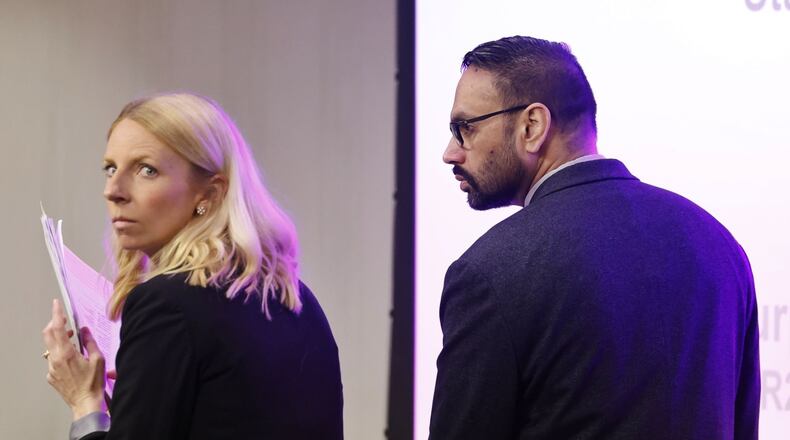A three-judge panel comprised of Judges Greg Howard, Greg Stephens and Keith Spaeth are weighing the evidence this time around. Singh’s first trial ended in a hung jury in October 2022.
The defense and prosecution agree Singh was present when four of his family members were shot and killed in their West Chester Twp. apartment, but the prosecutors say he was the killer, and the defense says he was a witness.
Hallie Dreyer, now a supervisor at the Ohio Bureau of Criminal Investigations, gave results of testing on multiple pieces of evidence collected by West Chester Police Twp. including a red shirt, jeans, socks, a belt Singh was wearing on the night of the slayings.
Shalinderjit’s DNA was found in blood on Singh’s T-shirt and jeans, which were stained with a large amount of blood, Dreyer testified. DNA from the other victims was not found on Singh.
Blood was located on the handle of gun prosecutors say was the murder weapon but was not suitable for testing, according to Dreyer.
The firearm, a Ruger SR9 9 millimeter, was thrown into a pond outside the apartment where it was not recovered for a couple days. That degrades the ability for successful DNA testing, Dreyer said.
None of the shell casings found at the scene tested positive for Singh’s DNA and one swabbing for blood from the patio outside that apartment was Hakikat’s, according to Dreyer.
Last week a parade of West Chester police officers testified Tuesday and Wednesday about evidence collection at the shooting scene on April 20, 2019, including a Beretta handgun with ammo in the closet of Singh’s bedroom and $930 cash on a prayer table beside one of the victims and $8,250 cash in a pink purse also located in the master bedroom.
The panel saw photos of the gun stuffed into a bag with Prosecutor Josh Muennich pointing out the gun was not the murder weapon, but evidence the “defendant had access to the firearm and ammunition at the time for the offense.”
The defense said Singh witnessed the shooting deaths of his family, but did not kill them, alluding to others with criminal backgrounds who had an ongoing land dispute with Hakikat Singh Pannag as suspects.
A portion of body camera footage was played in court as Sgt. Travis Oakes questioned Singh, who was distressed and paused answering questions, but identified the people living in the apartment.
When the man Singh called his brother, Maninder Sekhon Singh, showed up at the scene, Oakes said he was a person of interest. But a video was found at a UDF showing Maninder, his sister Harmanjot Sekhon, Singh’s children, and Harmanjot Sekhon there near the time of the murders.
During cross examination, defense attorney Alexandra Deardorff pointed out Oakes said he thought it was “odd” that Harmanjot did not call the Singhs after learning something happened at the residence. And at the time of the questioning Oakes said he did not believe he was getting the “whole truth.”
During opening statements, Assistant Prosecutor Jon Marshall said in addition to victims’ blood, gunshot residue and DNA found on Singh, GPS evidence can place Singh in the parking lot of the apartment complex at 9:03 p.m. That is 39 minutes before the 911 call was placed.
“He is here because he lied. In reality he was there and witnessed the brutality,” Deardorff said. “He probably should not have lied to the police; it does not make him a killer.”
All four victims were shot in the head, some multiple times.
Credit: Nick Graham
Credit: Nick Graham
At the time of the homicides, Singh was having an affair with a woman in Indianapolis whom he gave $20,000 cash to purchase a house, bought a car and paid a mortgage, Marshall said, pointing to motive.
Additionally, there was a strained relationship between Singh and his father-in-law with evidence of hostile demands by Singh to Hakikat for money, according to prosecutors.
Credit: Nick Graham
Credit: Nick Graham
About the Author







